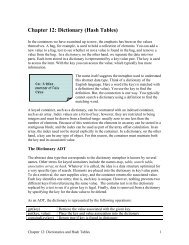Engineering Education and the Development of Expertise - Classes
Engineering Education and the Development of Expertise - Classes
Engineering Education and the Development of Expertise - Classes
Create successful ePaper yourself
Turn your PDF publications into a flip-book with our unique Google optimized e-Paper software.
100 (January 2011) 1 Journal <strong>of</strong> <strong>Engineering</strong> <strong>Education</strong><br />
Hadgraft, R. G., & Grundy, P. (1998). A new degree in civil engineering, Proceedings <strong>of</strong><br />
1st UICEE Annual Conference on <strong>Engineering</strong> <strong>Education</strong>, Monash University, Melbourne,<br />
Australia.<br />
Hake, R. R. (1998). Interactive-engagement versus traditional methods: A six-thous<strong>and</strong>-student<br />
survey <strong>of</strong> mechanics test data for introductory physics courses. American Journal <strong>of</strong><br />
Physics, 66(1), 64–74.<br />
Hazel, E., & Baillie, C. (1998). Improving teaching <strong>and</strong> learning in laboratories. Milpera, NSW,<br />
Australia: Higher <strong>Education</strong> Research <strong>and</strong> <strong>Development</strong> Society <strong>of</strong> Australasia.<br />
Hazzard, G. W. (1975). For <strong>the</strong> technological humanist: The WPI Plan. The American Biology<br />
Teacher, 37(1), 19–20.<br />
Hestenes, D., Wells, M., & Swackhamer, G. (1992). Force concept inventory. The Physics<br />
Teacher, 30(3), 141–158.<br />
Heywood, J. (2005). <strong>Engineering</strong> education: Research <strong>and</strong> development in curriculum <strong>and</strong> instruction.<br />
Piscataway, NJ: IEEE Press.<br />
Howard, D. R., & Miskowski, J. A. (2005). Using a module-based laboratory approach to incorporate<br />
inquiry into a large cell biology course. Cell Biology <strong>Education</strong>, 4(3), 249–260.<br />
Jamieson, L. H., & Lohmann, J. R.. (2009). Creating a culture for scholarly <strong>and</strong> systematic innovation<br />
in engineering education. Washington, DC: American Society for <strong>Engineering</strong> <strong>Education</strong>.<br />
Retrieved from http://www.asee.org/about-us/<strong>the</strong>-organization/advisory-committees/CCSSIE<br />
Johri, A., & Olds, B. (2011). Situated engineering learning: Bridging engineering education research<br />
<strong>and</strong> <strong>the</strong> learning sciences. The Journal <strong>of</strong> <strong>Engineering</strong> <strong>Education</strong>, 100(1), 151–185.<br />
Kadlowec, J., Bhatia, K., Ch<strong>and</strong>rupatla, T. R., Chen, J. C., Constans, E., Hartman, . . . Zhang,<br />
H. (2007). Design integrated in <strong>the</strong> mechanical engineering curriculum: Assessment <strong>of</strong> <strong>the</strong><br />
engineering clinics. Journal <strong>of</strong> Mechanical Design, 129(7), 682–691.<br />
Kember, D., & Gow, L. (1994). Orientations to teaching <strong>and</strong> <strong>the</strong>ir effect on <strong>the</strong> quality <strong>of</strong> student<br />
learning. The Journal <strong>of</strong> Higher <strong>Education</strong>, 65(1), 58–74.<br />
Kjærsdam, F. (2004). Technology transfer in a globalised world: transferring between university<br />
<strong>and</strong> industry through cooperation <strong>and</strong> education. World Transactions on <strong>Engineering</strong> <strong>and</strong><br />
Technology <strong>Education</strong>, 3(1), 63–66.<br />
Kolmos, A. (1996). Reflections on project work <strong>and</strong> problem-based learning. European Journal<br />
<strong>of</strong> <strong>Engineering</strong> <strong>Education</strong>, 21(2), 141–148.<br />
Kuh, G. D. (2003). The National Survey <strong>of</strong> Student Engagement: Conceptual framework<br />
<strong>and</strong> overview <strong>of</strong> psychometric properties. Bloomington, IN: Indiana University, Center for<br />
Postsecondary Research. Retrieved from http://nsse.iub.edu/pdf/conceptual_framework_2003.pdf<br />
Lattuca, L. R., Lambert, A. D., & Terenzini, P. T. (2008, April). Academic environments <strong>and</strong><br />
student learning: A finer-grained examination. Paper presented at <strong>the</strong> Annual Conference<br />
<strong>of</strong> <strong>the</strong> American <strong>Education</strong>al Research Association, New York, NY.<br />
Lattuca, L. R., Terenzini, P. T., Harper, B. J., & Yin, A. C. (2010). Academic environments in<br />
detail: Holl<strong>and</strong>’s <strong>the</strong>ory at <strong>the</strong> subdiscipline level. Research in Higher <strong>Education</strong>, 51(1),<br />
21–39.<br />
Lesh, R., &. Doerr, H. (2003). Beyond constructivism: Models & modeling perspectives on ma<strong>the</strong>matics<br />
problem solving, learning, & teaching. Mahwah, NJ: Lawrence Erlbaum.<br />
Lesh, R., Hoover, M., Hole, B., Kelly, A., & Post, T. (2000). Principles for developing<br />
thought-revealing activities for students <strong>and</strong> teachers. In A. E. Kelly & R. A. Lesh (Eds.),<br />
H<strong>and</strong>book <strong>of</strong> research design in ma<strong>the</strong>matics <strong>and</strong> science education (pp. 591–646). Mahwah, NJ:<br />
Lawrence Erlbaum Associates.<br />
147
















